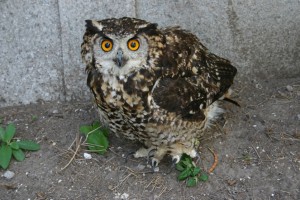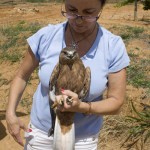Mackinder’s Eagle Owls in Kenya by Darcy Ogada

A population of Mackinder’s eagle owls in central Kenya has been the focus of ecological research in since June 2004. Darcy Ogada of the National Museums of Kenya and Paul Muriithi have been studying this population of approximately 16 pairs to determine the impacts of farming practices on the ecology and conservation of the owls. The owls’ nest and roost on cliffs adjacent to small farms in the lower reaches of the Aberdare Mountains. The owls are also a draw for bird tourists and the income generated from this supports individual farmers and community projects.
During the initial two and half years of research, the team, which also included interns from the National Museum, monitored owl nest sites, collected and analyzed pellets, trapped small mammals and measured crops in nearby farms to better understand the influence of farming practices on owls. The team also interviewed 72 farmers about their farming practices and attitudes toward owls.
Mackinder’s eagle owls in central Kenya are generalist predators capable of exploiting an agricultural niche that is devoid of most other predators. Our research has shown that the owls consume a wide variety of prey, 87% mammals, 7% birds and 5% insects. Farming practices are influencing both prey selection and abundance of Mackinder’s eagle owls. Owls respond to numerical fluctuations in small mammals and may play an important role in controlling farm pests. Irrigated farms provide owls with a year-round food source. However, diet diversity of this population of owls is high and this may have negative long-term consequences for owl productivity and some farming practices continue to threaten this population, particularly the poisoning of owl prey with pesticides.
Farmers we interviewed said pests were the most serious problem they faced. Only 28% of farmers said they controlled vertebrate pests using pesticides, but we also noticed that carbofuran (tradename Furadan) was often misused to kill vertebrate pests. Most farmers (68%) said they didn’t believe in the culturally negative beliefs about owls and 75% knew at least one type of owl prey. Farmers who benefited from owl tourism were more likely to know about owl diet and habits, but this did not have a positive effect on farmers’ behaviour toward owls. This was probably a result of a lack of ecological literacy rather than any direct antagonism toward owls.
Paul continues to monitor the owls each month and we plan to publish long-term data on the owls’ productivity and breeding ecology. Further information about our project is on our website: www.owlspot.com
Our project has been generously supported by: National Geographic Conservation Trust, SeaWorld &Busch Gardens Conservation Fund, The Peregrine Fund, World Owl Trust, Raptor Research Foundation, Leslie Brown Memorial Grant, John Ball Zoo Society Wildlife Conservation Fund, Tarrytown FWC and Miami Metrozoo.
Publications include:
Ogada, D.L. and P.M. Kibuthu. In press. Impacts of agriculture on the diet and productivity Mackinder’s eagle owls (Bubo capensis mackinderi) in Kenya. Biotropica
Ogada, D.L. In press. Agricultural practices, rural culture and the conservation of Mackinder’s eagle owls in Central Kenya. Proceedings of the 2007 International Owl Conference
Ogada, D.L. and P.M. Kibuthu. 2008. Conserving Mackinder’s eagle owls in farmlands of Kenya: assessing the influence of pesticide use, tourism and local knowledge of owl habits in protecting a culturally loathed species. Environmental Conservation 35(3): 252-260.
Ogada, D. L. 2008. Rural culture and the conservation of Mackinder’s eagle owls (Bubo capensis mackinderi) in Kenya. Notes from the Field. Journal of Avian Medicine and Surgery 22(2): 158-160.
Ogada, D. 2008. Tackling the taboos: gaining community support for the conservation of an owl. Africa Birds & Birding, Vol. 13, No. 5, Oct/Nov.
Ogada, D. 2004. Owls and ‘Taboo’. Swara, Magazine of the East African Wildlife Society, Vol. 27:3, Jul-Sep.





wow this is great work and i have admired it,i recorgonise paul muriithi as a great man,because i have known him from my childhood thankyou and continue with your great work.
Hi there…
I am very impressed by your work on this, a very impressive and beautiful species! Thank you for listing your publications on this as well – I will try and track these down as i find it very interesting… I certainly enjoyed your article in AB&B.
I take it that the chief farming practice in the area is crop farming…? What is the main/most common crop farmed in the area? I find it interesting that the reliable supply of food from the farms influence the long term productivity of these owls with an otherwise diverse diet, as i am working with a species that seems to specialize on a more specific prey, and the habitat loss caused by crop farming appears to affect the species negatively.
I am conducting my own research on a species of owl in South Africa, the African Grass-owl. As far as I am aware the grass-owl also occurs in east Africa. Do they occur in Kenya, and if so what do think is the status of these birds in your region? I am inteseted in this as they are ‘vulnerable’ in our regional red list for birds, and they appear to be a species under serious threat from habitat loss, mainly due to agricultural activities.
Thank you for an informative article!
Matt Pretorius
Pretoria
South Africa
Hi Darcy, nice to see your name again, still working with my mackinders 3 eggs this year, one clear and the other two chicks died as they “pipped” and did not hatch not sure why but will see what the coming season brings.
Trust you are well
regards Steve
I enjoy seeing owls gliding at Narumoru past my small house in the evening as they pass from Mt Kenya to Aberdare ranges.Its nice.
Just came across your information on the Mackinder’s Eagle Owl. As you can see my last name is Mackinder and was wondering if you have any information on how/why it got its name.
In response to D. Mackinder
A British explorer by the name of Halford Mackinder was the first European to ascend Mt Kenya. Mackinder’s eagle owls are confined to the highlands in Kenya, it is fairly common in the moorlands on Mt Kenya. There is also Mackinder’s camp, which serves a basecamp for summiting Mt Kenya. Incidentally, Mackinder’s eagle owl is one of two subspecies of the Cape Eagle Owl. There is another subspecies in Ethiopia and Eritrea, but to my knowledge it does not have a common name.
Darcy
Hi Darcy,
I have been reading some of your work and am very interested. I am currently looking for a PhD position in raptor disease reseach and am finding it difficult. I would appreciate any help or advice you could offer. Im an irish citizan and would be willing to travel.
Therese
Hi Therese,
Why don’t you email me at darcyogada@yahoo.com and we can discuss.
Thanks, Darcy
What is the economic value of the owl?
How can an individual benefit from the owl without necessarily endangering them?
hi
i have seen little young owls near where i live.if you would love to see them let me know.they are located in nakturu rongai division.They are many here.
you can also see thge pictures at my blog.
regards
james
Owls are birds which are unique and known for good fortune and sometimes bad fortune, they are also asociated to treatment of sick people. I have one nesting at my place and it has laid seven eggs. I’ve had roumous that an owl’s egg is an expensive commodity, is this true?